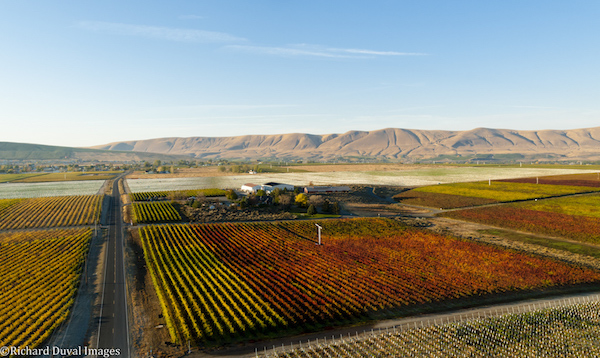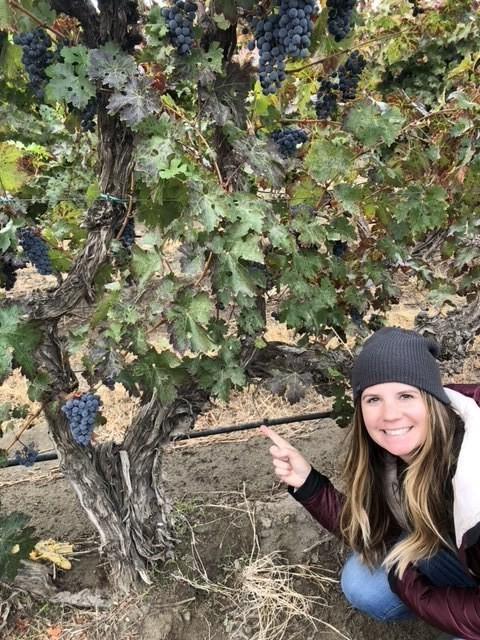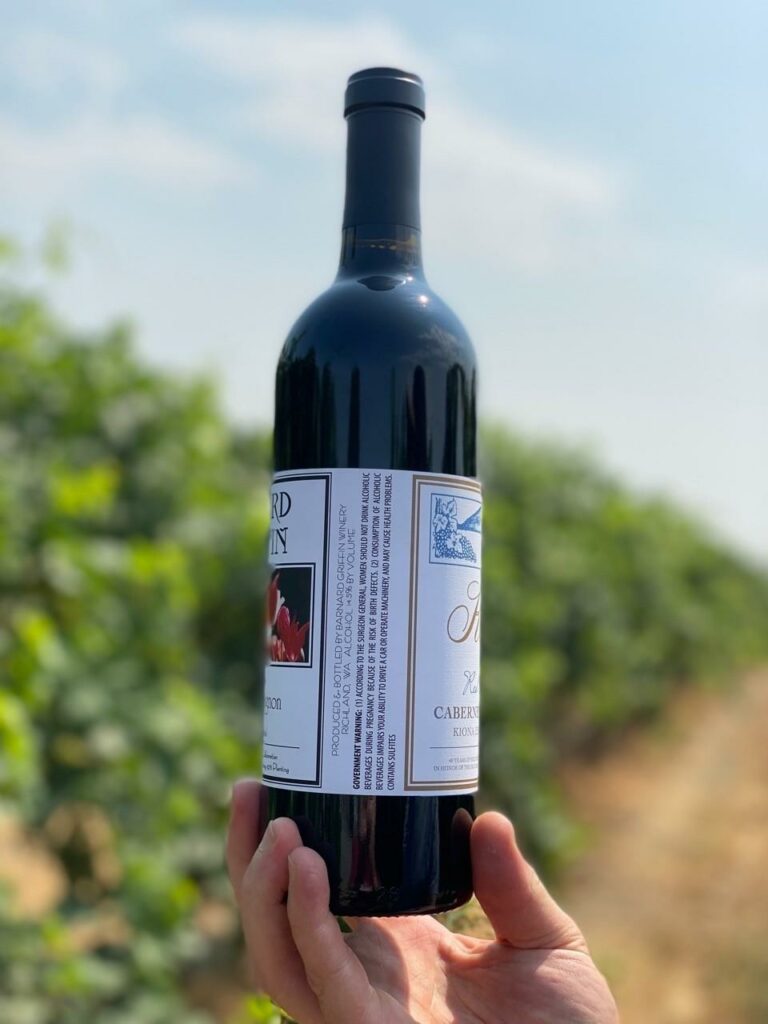
RICHLAND, Wash. — Ask either Scott Williams or Rob Griffin how long they’ve known one another and it’s likely they will look back upon the same day during the harvest of 1978.
Scott, who now oversees the vineyards his parents began planting in 1975 with their then-partner Jim Holmes and of the family’s Kiona Vineyards and Winery, remembers the occasion well. That’s because the first Cabernet Sauvignon grapes picked that year went to Preston Premium Wines in Pasco, Wash., where Griffin was the winemaker.
Griffin, head winemaker and co-owner with his wife Deborah Barnard of Barnard Griffin Winery since 1983, recalls it well because the quality of those grapes from the dusty, sun-baked and wind-blown slopes of sagebrush, rabbitbrush and cheatgrass above the Yakima River shattered the conventional wisdom of the day — that Washington “was a first-class white wine region with limited prospects for reds.”
“My opinion was permanently changed in 1978 with the opportunity to crush the first crop from Kiona Vineyard on Red Mountain,” he recounts on Kiona’s website. “ … The first yielded wines (were) of tremendous depth and intensity, real diamonds in the rough and a foreshadowing of great things to come.”
Indeed, those wines Griffin made for Bill Preston were the first commercial releases made with Red Mountain grapes.
That harvest also marked the start of an ongoing 43-year relationship that grew into a friendship between their families and a gradual realization that the two wine industry pioneers had laid the foundation for what would become in 2001 the Red Mountain American Viticultural Area.
Red Mountain landscape shifted with Kiona plantings

Today, Kiona’s airy, modern tasting room with vistas of the Cascade Mountains and snow-capped Mount Adams is surrounded by more than 2,000 green acres of world-class grapes.
“We would drive to the vineyard in a 1969 Plymouth Fury station wagon,” Scott remembers. “… The road was so bad at the start. It was really just a path through the desert. There were these soft dunes made of ultra-fine dust that you’d have to build up speed to bust through or else you’d get stuck. … it came in through the vents in the car. It was like throwing flour in someone’s face, except dirt.”
John later recalled that he and Holmes, back then fellow engineers working at the Hanford Site, had set out a few years earlier to learn about grape growing by working with Walter Clore, the Washington State University grape researcher whose work provided a guide for the state’s wine industry.
“We wanted to learn as much as we could,” the Kiona Vineyards website quotes John as saying, “and getting dirty seemed to be the best way of doing it.”
Scott jokes that “getting dirty” included a lot of child labor. At times, he enlisted high school classmates to help. Once they broke into a chorus of Chain Gang — Sam Cooke’s famous song — as Williams urged them to finish up the day’s tasks despite a huge swarm of gnats that clogged their noses. His classmates got to go home. For Scott, there was always plenty more work.
“My Dad and his partner had read that you needed to plant two sticks (cuttings from a grape vine) for every one plant that would survive. So they planted two sticks” in each planting spot.
The two engineers took that concept as gospel, Scott added.
“The problem was that the numbers were about right, but usually both sticks in a planting either died or survived. We kids were given a posthole digger and told to move one of the survivors to fill the gaps.”
During the next four decades, the Williams family operation would grow thoughtfully and prosper. Along the way, the Williams and the Holmes families split their operation. Then, John and his wife Ann could retire from active participation. Scott, his wife Vicky and their two sons have continued to plan, develop and expand. They now own five vineyards that spread across 272 of the Red Mountain AVA’s 4,040 acres.
Kiona, Barnard Griffin evolve while looking back

Kiona produces a wide array of wines — white, rosé and red — including the Cabernet Sauvignon, Merlot and Syrah that are the staple of Red Mountain producers. The Williams clan also continues to nurture several blocks of grapes planted in the late 1970s and early 1980s, and those still produce delightful gems, including a Chenin Blanc ice wine, a dry Chenin Blanc, and a now rarely planted Lemberger that Clore championed as perfect for Washington.
Griffin, meanwhile, went from working for Preston to Hogue Cellars in Prosser, and then founded Barnard Griffin.
In the decades since, Griffin’s stable of wines has regularly featured Red Mountain fruit from Williams vineyards. In addition to the expected red and white varietals, he’s long been known nationally for his Rosé of Sangiovese, his Riesling, currently being sold at Trader Joe’s outlets, and his reserve tier of reds and whites. Those include a red Côtes du Rôb and a Côtes du Rôb Blanc, a neat evasion of the prohibition from using Côtes du Rhône.
Both their operations share a philosophy of avoiding debt, helping out friends and providing excellence at consumer-friendly prices. And there also are some higher-tier bottlings for their wine club members and devoted followers.
2nd Harvest Food Bank benefits from 2018 Legacy Cab
The label for the Barnard Griffin Winery 2018 Kiona Estate Vineyard Legacy Collaboration Cabernet Sauvignon will be a one-piece wraparound featuring “throwback” versions of the Kiona Vineyards and Barnard Griffin labels. (Photos courtesy of JJ Williams)
To celebrate that first vintage, on Tuesday, Aug. 3, the families are announcing the Barnard Griffin Winery 2018 Kiona Estate Vineyard Legacy Collaboration Cabernet Sauvignon made from the 40th vintage of that 1975 planting of Cab at Kiona. It’s crafted once again by Rob Griffin — this time with his daughter Megan Hughes — at the Barnard Griffin cellar in Richland.
It’s the brainchild of Scott’s son JJ, now Kiona Vineyards and Winery’s general manager, and Megan, Barnard Griffin’s white winemaker. It was sparked by an idea JJ broached in an email to her about three years ago.
“All the credit goes to JJ,” Hughes said, describing how they developed a plan to mark the legacy of their two families as key players in the founding of Washington’s modern wine industry.
JJ says, “Our operations share a lot in common, and we’ve grown up in parallel over the decades. That shared history is worth celebrating.”
The Williams family, including JJ’s brother Tyler, who took over winemaking duties at Kiona from Scott in 2019, made the concept a reality by growing a crop they believe has turned into a superb Cabernet Sauvignon crafted by Hughes and her father. It’s a limited release of about 100 cases — just four barrels, two of them new French oak — with all proceeds going to Second Harvest Food Bank. The organization operates 280 food pantries and meal sites in Eastern Washington and Northern Idaho that help provide assistance to families who struggle to put food on their tables every day.
“We want to tell our story,” Hughes said, “and help out the local community.”
The wine can be purchased via this link in a three-bottle lot — $300 total. The sale includes two tickets to the Sept. 25 release party at Kiona Vineyards as an added incentive to support the effort. That event gives buyers the opportunity to sample the 2018 Legacy Cab and dine on food provided by J. Bookwalter Winery’s NON-FICTION food truck and Stick+Stone Wood-Fired Pizza.
Those who buy the fundraising wine will get to experience one of Washington’s states finest reds grown and crafted by two families who combined have more than 100 years of grape-growing and winemaking experience.




Ken,
Thanks for weaving this nostalgic tapestry of memories. From the early visions and labors of the Williams, Holmes, and Preston families, to the multi-generational wine-making legacies of the Griffin/Hughes/Williams/Holmes families, and the J Bookwalter family contributions to the Tri-Cities wine culture.
Methinks, you have a keen eye for the relevant, sir.